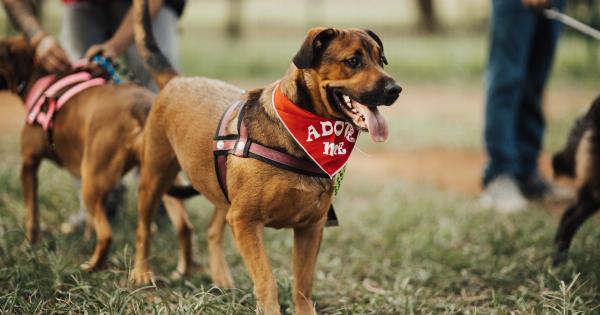Many dog owners have observed their furry friends showing interest in television screens. It’s not uncommon to see dogs closely watching the movements and actions displayed on TV.
This has led dog owners to wonder if dogs can actually recognize images on television. In this article, we will explore whether dogs have the ability to perceive and understand what they see on TV.
Visual Capabilities of Dogs
Before determining whether dogs can recognize images on TV, it is important to understand the visual capabilities of these marvelous creatures. Dogs have excellent motion detection skills due to their evolutionary background as predators.
Their visual acuity, however, is not as sharp as that of humans. While a dog’s visual acuity is approximately 20/75, much lower than humans’ 20/20 vision, they compensate for this through their other senses like hearing and smell.
Dogs and Television
Now let’s delve into the intriguing question of whether dogs can recognize images on TV. Dogs’ viewing experience of television is quite different from ours. Unlike humans, dogs do not perceive television in the same way.
For them, the moving images on the screen might appear as a series of flickering lights, lacking the detail and clarity that we perceive.
However, dogs do have the ability to detect motion on TV screens, which often captivates their attention. This is mainly due to their innate ancestral instincts as predators.
The subtle movements or quick actions on the screen can trigger a dog’s prey drive, making them curious and engaged in what they are seeing.
Recognizing Dogs on TV
One intriguing aspect is whether dogs can recognize other dogs when they appear on television. Studies have shown that dogs are indeed capable of recognizing their fellow canines on TV screens.
This is mainly attributed to their highly developed sense of smell, which allows them to detect scent cues, even from a two-dimensional image. Dogs can identify the unique scent patterns of other dogs and associate them with the visual representation on the screen.
However, it is important to note that not all dogs react the same way to seeing other dogs on TV. Some dogs may respond with excitement, barking, or jumping up towards the screen, while others may show no interest at all.
The individual dog’s personality, prior experiences, and overall training play significant roles in determining how they react to visual stimuli on television.
Limitations of Dog’s Vision on TV
Despite their ability to recognize certain images, it is essential to understand the limitations of dogs’ vision on TV. Dogs have a limited ability to perceive details and colors on screens.
The low refresh rate and resolution of older televisions may further decrease their visual comprehension. Modern high-definition screens, however, with their higher refresh rates and improved resolution, offer a more realistic viewing experience for dogs.
Another factor to consider is the content on TV itself. Dogs may respond differently to different types of programming.
For instance, nature documentaries with animal movements and sounds might captivate their attention more than a static image or a sports match. The level of engagement largely depends on the content and the dog’s personal preferences.
Interacting with TV
Many dog owners wonder if their pets can interact with TV screens, such as trying to paw at objects or attempting to catch animals they see.
While it may appear as if dogs are trying to interact, they often lack a true understanding of the two-dimensional nature of the screen. The lack of physical feedback can confuse them, as their actions have no impact on the images they see.
That being said, there are interactive technologies designed specifically for dogs to engage with television. These technologies utilize sensors or cameras to detect a dog’s movements and generate corresponding responses on the screen.
Such interactive programs and games are developed to enhance dogs’ mental stimulation and physical activity.
Dogs and Sound on TV
While dogs may be limited in their visual comprehension on TV, their acute hearing capabilities make up for it. Dogs have a wide range of hearing, enabling them to pick up sounds that are beyond the human auditory range.
This means that they can hear high-frequency sounds or faint noises coming from the TV and react accordingly.
Television programs with animal sounds, doorbells, or sirens might elicit different responses from dogs. They may tilt their heads, perk up their ears, or start investigating the source of the sound.
This emphasizes the importance of sound in capturing a dog’s attention and engaging them with the television.
Training and TV Viewing
Training plays a vital role in how dogs respond to television images. Dogs that are well-trained and accustomed to various visual and auditory stimuli tend to show better comprehension of what they see on TV.
Introducing dogs to television at a young age and gradually exposing them to different programs can help them become more comfortable with the medium.
Using positive reinforcement techniques during TV viewing sessions can also be beneficial. Rewarding dogs for calm behavior and positive associations with the TV can encourage them to engage and interact with the screen in a controlled manner.
This training can be especially useful when watching programs that involve animals or natural sounds, allowing dogs to channel their instincts in a positive way.
Conclusion
In conclusion, while dogs may not recognize images on TV screens as we do, they do possess the ability to detect motion and react to certain visual stimuli.
Dogs’ evolution as predators and their highly developed senses provide them with a unique perspective on television. Although their visual acuity is not as sharp as humans’, dogs can still recognize fellow dogs on screen, thanks to their exceptional sense of smell.
It is important to remember that individual dogs may respond differently to television and its content. Factors such as personality, prior experiences, training, and the nature of the visuals all contribute to a dog’s viewing experience.
Responsible dog owners can use positive reinforcement training techniques and interactive programs to enhance their dogs’ interaction with the TV.






























